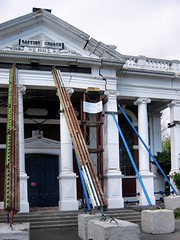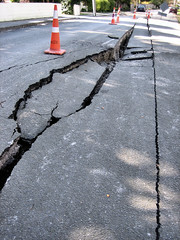
Search
Images for Canterbury earthquake; more images...
Pleasant Point Yacht Club
Images, eqnz.chch.2010
Badly damaged in both the September and February quakes and over 6000 aftershocks the Point Pleasant yacht club had started to sink into the Avon estuary before being demolished in July 2011 after the June 6.3 earthquake
Townsend Telescope Pre-Earthquake Photographs 02
Images, UC QuakeStudies
A photograph of the Townsend Telescope in the Observatory at the Christchurch Arts Centre. In the bottom right-hand corner of the photograph is a pulley for the telescope's clock drive. This is one of the pieces that went missing when the Observatory tower collapsed in the 22 February 2011 earthquake. This image was used by Graeme Kershaw, Technician at the University of Canterbury Department of Physics and Astronomy, to identify the telescope's parts after the 22 February 2011 earthquake.
Townsend Telescope Pre-Earthquake Photographs 09
Images, UC QuakeStudies
A photograph of the middle section of the Townsend Telescope. The telescope is in the Observatory at the Christchurch Arts Centre. A plate on the side reads, "T Cook & Sons, 1864, York & London". This image was used by Graeme Kershaw, Technician at the University of Canterbury Department of Physics and Astronomy, to identify the telescope's parts after the 22 February 2011 earthquake.
Townsend Telescope Pre-Earthquake Photographs 01
Images, UC QuakeStudies
A photograph of Wayne Smith and Ken Vickery inside the Observatory at the Christchurch Arts Centre, taken in the 1970s. Smith and Vickery are pictured next to the Townsend Telescope, which they have just refurbished. No repair work was necessary during this process.
Townsend Telescope Pre-Earthquake Photographs 08
Images, UC QuakeStudies
A photograph of the middle section of the Townsend Telescope. The telescope is in the Observatory at the Christchurch Arts Centre. A plate on the side reads, "T Cook & Sons, 1864, York & London". This image was used by Graeme Kershaw, Technician at the University of Canterbury Department of Physics and Astronomy, to identify the telescope's parts after the 22 February 2011 earthquake.
Townsend Telescope Pre-Earthquake Photographs 10
Images, UC QuakeStudies
A photograph of the Townsend Telescope. The telescope is in the Observatory at the Christchurch Arts Centre. A plate on the side reads, "T Cook & Sons, 1864, York & London". This image was used by Graeme Kershaw, Technician at the University of Canterbury Department of Physics and Astronomy, to identify the telescope's parts after the 22 February 2011 earthquake.
20100906-122338.jpg
Images, eqnz.chch.2010
None
20100906-113924.jpg
Images, eqnz.chch.2010
None
20100906-115226.jpg
Images, eqnz.chch.2010
None
20100906-113917.jpg
Images, eqnz.chch.2010
None
20100906-115341.jpg
Images, eqnz.chch.2010
None
20100906-115142.jpg
Images, eqnz.chch.2010
None
20100906-115224.jpg
Images, eqnz.chch.2010
None
20100906-114141.jpg
Images, eqnz.chch.2010
None
20100906-120300.jpg
Images, eqnz.chch.2010
None
20100906-120331.jpg
Images, eqnz.chch.2010
None
20100906-120243.jpg
Images, eqnz.chch.2010
None
20100906-115607.jpg
Images, eqnz.chch.2010
None
20100906-115102.jpg
Images, eqnz.chch.2010
None
20100906-120216.jpg
Images, eqnz.chch.2010
None
20100906-114226.jpg
Images, eqnz.chch.2010
None
20100906-120228.jpg
Images, eqnz.chch.2010
None
20100906-120310.jpg
Images, eqnz.chch.2010
None
AN EXPLORATION OF THE DEVELOPMENT AND CURRENT USE OF THE CONCEPT OF “VULNE…
Research papers, University of Canterbury Library
These research papers explore the concept of vulnerability in international human rights law. In the wake of the Christchurch earthquakes of 2010-2011, this research focuses on how "vulnerability" has been used and developed within the wider human rights discourse. They also examine jurisprudence of international human rights bodies, and how the concept of "vulnerability" has been applied. The research also includes a brief investigation into the experiences of vulnerable populations in disaster contexts, focusing primarily on the experiences of "vulnerable persons" in the Christchurch earthquakes and their aftermath.
People in Disasters Conference - Understanding Immediate Human Behaviour t…
Videos, UC QuakeStudies
A video of a presentation by Professor David Johnston during the fourth plenary of the 2016 People in Disasters Conference. Johnston is a Senior Scientist at GNS Science and Director of the Joint Centre for Disaster Research in the School of Psychology at Massey University. The presentation is titled, "Understanding Immediate Human Behaviour to the 2010-2011 Canterbury Earthquake Sequence, Implications for injury prevention and risk communication".The abstract for the presentation reads as follows: The 2010 and 2011 Canterbury earthquake sequences have given us a unique opportunity to better understand human behaviour during and immediately after an earthquake. On 4 September 2010, a magnitude 7.1 earthquake occurred near Darfield in the Canterbury region of New Zealand. There were no deaths, but several thousand people sustained injuries and sought medical assistance. Less than 6 months later, a magnitude 6.2 earthquake occurred under Christchurch City at 12:51 p.m. on 22 February 2011. A total of 182 people were killed in the first 24 hours and over 7,000 people injured overall. To reduce earthquake casualties in future events, it is important to understand how people behaved during and immediately after the shaking, and how their behaviour exposed them to risk of death or injury. Most previous studies have relied on an analysis of medical records and/or reflective interviews and questionnaire studies. In Canterbury we were able to combine a range of methods to explore earthquake shaking behaviours and the causes of injuries. In New Zealand, the Accident Compensation Corporation (a national health payment scheme run by the government) allowed researchers to access injury data from over 9,500 people from the Darfield (4 September 2010) and Christchurch (22 February 2011 ) earthquakes. The total injury burden was analysed for demography, context of injury, causes of injury, and injury type. From the injury data inferences into human behaviour were derived. We were able to classify the injury context as direct (immediate shaking of the primary earthquake or aftershocks causing unavoidable injuries), and secondary (cause of injury after shaking ceased). A second study examined people's immediate responses to earthquakes in Christchurch New Zealand and compared responses to the 2011 earthquake in Hitachi, Japan. A further study has developed a systematic process and coding scheme to analyse earthquake video footage of human behaviour during strong earthquake shaking. From these studies a number of recommendations for injury prevention and risk communication can be made. In general, improved building codes, strengthening buildings, and securing fittings will reduce future earthquake deaths and injuries. However, the high rate of injuries incurred from undertaking an inappropriate action (e.g. moving around) during or immediately after an earthquake suggests that further education is needed to promote appropriate actions during and after earthquakes. In New Zealand - as in US and worldwide - public education efforts such as the 'Shakeout' exercise are trying to address the behavioural aspects of injury prevention.
Site-Specific Probabilistic Seismic Hazard Maps of New Zealand for 475 yea…
Research papers, University of Canterbury Library
The latest two great earthquake sequences; 2010- 2011 Canterbury Earthquake and 2016 Kaikoura Earthquake, necessitate a better understanding of the New Zealand seismic hazard condition for new building design and detailed assessment of existing buildings. It is important to note, however, that the New Zealand seismic hazard map in NZS 1170.5.2004 is generalised in effort to cover all of New Zealand and limited to a earthquake database prior to 2001. This is “common” that site-specific studies typically provide spectral accelerations different to those shown on the national map (Z values in NZS 1170.5:2004); and sometimes even lower. Moreover, Section 5.2 of Module 1 of the Earthquake Geotechnical Engineering Practice series provide the guidelines to perform site- specific studies.
Townsend Telescope: Part Photograph 11
Images, UC QuakeStudies
A photograph of the earthquake-damaged output shaft from the top-plate of the Townsend Telescope's clock drive. The output shaft was bent out of shape during the 22 February 2011 earthquake.
People in Disasters Conference - Canterbury Primary Care Response to Earth…
Videos, UC QuakeStudies
A video of a presentation by Dr Phil Schroeder, Managing Director of Rolleston Central Health, during the second plenary of the 2016 People in Disasters Conference. The presentation is titled, "Canterbury Primary Care Response to Earthquakes in 2010/2011".
20100906-151302.jpg
Images, eqnz.chch.2010
None
20100906-151248.jpg
Images, eqnz.chch.2010
None



